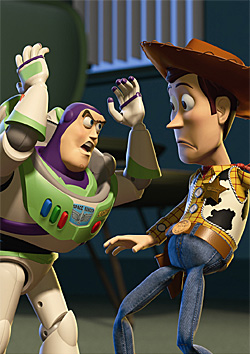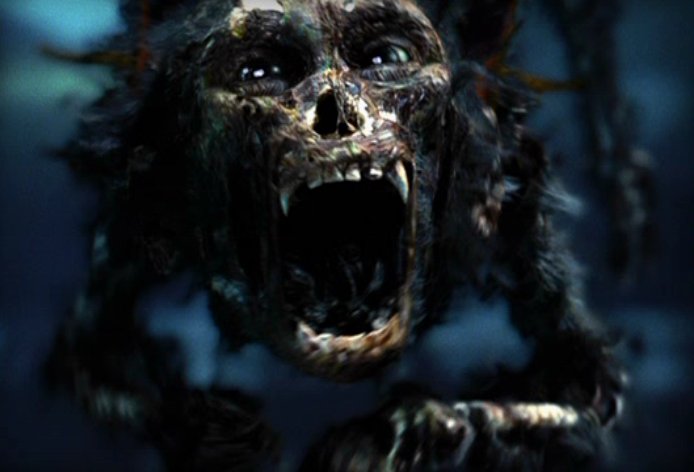Month: October 2009
Woody and Buzz in 3-D!
SDG here jumping with joy at the thought of seeing two early Pixar classics in theaters, back-to-back, in 3-D!

“You… are… a… TOY!”
Toy Story and Toy Story 2 are back in theaters in a double feature, and they’ve been converted to Disney Digital 3-D. This is in anticipation of next year’s debut of Toy Story 3 in 3-D.
Converting a computer-animated film like the Toy Story films to 3-D is an entirely different proposition from doing a 3-D conversion on a movie like, say, Tim Burton’s The Nightmare Before Christmas (which will also be back in theaters in 3-D in a couple of weeks or so).
The Nightmare Before Christmas is stop-motion animation, which means it was filmed using real 3-D objects in real space. Had they wanted to make it 3-D originally, it would have been comparatively easy to film it in 3-D the same way you would a live-action movie, by using two cameras together, one for the left-eye perspective and one for the right-eye perspective.
That’s how 3-D works: by presenting two slightly different perspectives on the same action to each of your two eyes, which your brain compiles into a single 3-D perception of spatial relations. That’s the way you perceive actual 3-D space too: Your left eye and your right eye have slightly different perspectives on the world, and your brain does the math of mapping how close or far objects are depending on how different the perceptions are from each eye. The further away objects are, the less difference it makes to your left eye versus your right eye; the closer objects are, the more different they appear and the more their position shifts relative to one eye versus the other.
For example, your left-eye view of your nose is completely different from your right-eye view of your nose, because your nose is really, really close to your eyes. Looking at these words on the computer screen, if you close first one eye and then another, you’ll see the words jump slightly to the left or the right — but not as much as your nose, which jumps completely from one side of your visual field to the other side. Then if you look out a window at objects that are far away, they shift even less.
Of course, whenever you have one eye closed, you’re seeing a 2-D view on the world, just like a photograph or a movie, although your brain still understands space well enough to work with a 2-D picture — though not as well as if you can use both eyes.
Among other things, even with one eye, your brain makes judgments about space not only based on the same sort of judgments you make looking at a photograph, but also as your head moves your brain gathers additional information about what things look like from different perspectives, and uses that information to make better judgments about distance.
Ever seen a cat bob its head up and down before making a jump? Same thing — it’s gathering more information to make the best possible estimation of the distance. It’s almost like having four eyes instead of just two. (I think maybe some athletes, like tennis players, might get a similar benefit by swaying back and forth, though that’s probably mostly about being ready to move in any direction.)

“What’s this?!”
Anyway, getting back to The Nightmare Before Christmas, although it would have been comparatively easy to film in 3-D originally, in fact like any non–3-D film it was filmed with a single camera point of view, which means that now all the information about those objects in space has been reduced to a 2-D image representing a single point of view — not enough to create a 3-D image.
Creating a 3-D effect in that case means extrapolating (i.e., creating) additional information that doesn’t exist on the film about what those objects would look like from two different points of view, as well as what we would see of objects behind them if we had a slightly different perspective, etc. In other words, you have to cheat and make stuff up. Fortunately, computers are powerful tools and the effect is pretty good, though not as good as filming in 3-D in the first place.
With Toy Story, though, it’s completely different. The great thing about computer animation is that even though the film images were rendered by computers in 2-D, prior to being rendered the films were staged and animated in a virtual 3-D environment — and all that lovely 3-D information still exists on hard drives at Pixar. For example, in a scene in which we see Andy playing with Woody and Buzz, we see them on screen from only one perspective — but the animators originally mapped out where Andy, Woody and Buzz were in relation to one another in virtual 3-D, and the computer files with that information still exist.
In principle, the animators could swing the virtual “camera” 180 degrees around the room and render to show us Andy, Woody and Buzz from the back — or what it would look like from a bird’s eye view over their heads, etc. You could never do that with a 2-D film like The Nightmare Before Christmas — you’d essentially be painting an entirely new image with all-new information.)
To give us 3-D, though, Pixar just have to render two different points of view similar to the original camera angle for a left-eye and a right-eye shot.
Then both images are projected on the screen at the same time, and the images are filtered for the left eye and the right eye using polarization, i.e., controlling how the light waves move for each of the two images and then using polarized 3-D glasses to filter for light traveling in one direction versus the other. (In the old days of 3-D, polarization was linear, e.g., vertical or horizontal, but newer circular polarization, which is left or right, is much better and doesn’t depend on the angle of your head. With the old linear-polarized glasses, if you put two pairs of glasses together and turned one at right angles to the other, you would see almost nothing. That wouldn’t work with circular polarized glasses — but I bet it would if you opposed them face to face.)
None of this, of course, has anything to do with why Toy Story and Toy Story 2 are such classics … for that, you can read my reviews. (Oh, and The Nightmare Before Christmas, not exactly a classic, but quite a fun little film, and fun to revisit around Halloween.)
Next week: The return of the Petrine Fact!